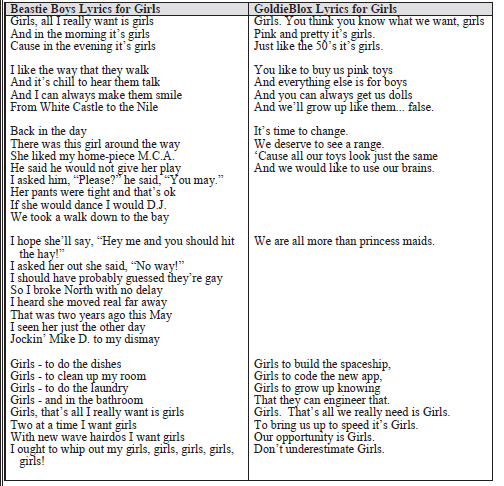Coverage has exploded this week of a dispute between the Beastie Boys and a company called “GoldieBlox,” over the latter’s use of the song “Girls” in a video encouraging engineering and structural play toys for girls. Despite coverage focusing on whether Goldie Box copied the Beastie Boys’ song (which is undisputed, really, and thus beside the the point in this case), the fair use of the earlier song is clear: the new version is a parody of a leering anthem, intended to subvert inherent sexism into a message of empowerment. Curiously, however, the fair use in another video on the company’s site using the Queen song “Bohemian Rhapsody” seems less clear, but so far unnoticed.
GoldieBlox describes itself as follows: “At GoldieBlox, our goal is to get girls building. We’re here to help level the playing field in every sense of the phrase. By tapping into girls' strong verbal skills, our story + construction set bolsters confidence in spatial skills while giving young inventors the tools they need to build and create amazing things.”
In pursuit of this, the company created a video showing several girls staring blankly at a TV exhorting stereotypical “girly” attributes. The xylophone-like leitfmotif of the Beastie Boys begins, and a chorus of girls’ voices begins singing an alternate version in the background, while the girls in the video construct and use a Rube-Goldberg-style contraption around the house. The differences in lyrics are as follows:
This is as clear a case of fair use as you will find outside of academic scholarship; it is the very essence of a parody that the First Amendment protects. Indeed, it is almost a precise parallel of the Campbell case, but in reverse. Campbell v. Acuff-Rose Music (92-1292), 510 U.S. 569 (1994), is the definitive authority on fair use (recent confusion notwithstanding), and it addressed this very scenario: an authorized version of a copyrighted song. 2 Live Crew released a version of Roy Orbison’s iconic song that failed, to say the least, to accord the original version any respect. Instead, the 2 Live Crew song was deliberately salacious and propositioning, while using the exact same melody and substantial lyrical overlap. The Supreme Court first answered the then-open question of whether 2 Live Crew’s commercial use of the song disqualified a fair use defense, holding that it did not. Then, the Supreme Court created laid the groundwork for the now-controversial “transformative” debate, noting that 2 Live Crew had changed the song from a somewhat romantic courtship by a shy protagonist, to a “bawdy” proposition and call to promiscuity. This, then, was the point: the rap group had transformed the meaning of the original song substantially.
Against this framework, Goldie Box will prevail in any reasoned application. “Girls,” somewhat less profanely but no more gently, is the very essence of objectification—as acknowledged by the band members themselves in later years, seeking to mitigate a negative reputation. GoldieBlox stands on the foundation of that objectification and declares the intelligence and capability of young girls. It could scarcely be more transformative. So, when you read dismissive commentary that GoldieBlox is just seeking attention, or that it has commercial motives, remember (1) the subtext of such comments, and (2) that they are wrong. It is also a combined audiovisual work rather than merely a song, further transforming the original. Beyond that, the Beastie Boys will be hard pressed to argue that this video will depress sales for License to Ill, unless sales dip because of implicit criticism, which is allowable under the Copyright Act. Put another way, no one is going to skip over a Beastie Boys CD (if they still make those) for their holiday shopping because of this video.
Notably, the video still appears on YouTube, which means that the Beastie Boys have either (1) not demanded a Digital Millennium Copyright Act takedown, or (2) YouTube declined. The company has sued the band preemptively for a declaration that its use is fair use. In response (so far), the Beastie Boys apparently wrote an “open letter” to the company declaring its admiration but withholding its consent to the use:
“We strongly support empowering young girls, breaking down gender stereotypes and igniting a passion for technology and engineering. . . as creative as it is, make no mistake, your video is an advertisement that is designed to sell a product, and long ago, we made a conscious decision not to permit our music and/or name to be used in product ads…When we tried to simply ask how and why our song ‘Girls’ had been used in your ad without our permission, YOU sued US.”
This will matter only insofar as the company needs a license, which if fair use applies it does not. The band has no power to determine what use is made beyond what the copyright encompasses (which, to be clear, is substantial). An additional wrinkle is that deceased Beastie Boy Adam Yauch (MCA) apparently forbade the use of his image or work in advertising, but his power to do so also extends only so far as copyright will take it. Once fair use allows a secondary use, his will is irrelevant.
Lastly, it bears noting that the company’s website has another video to the tune and altered lyrics of the Queen standard “Bohemian Rhapsody.” This video is far more elegiac and, arguably, consistent with the tone of the original song. No dispute has arisen, but it would be interesting to consider the possible outcome.




